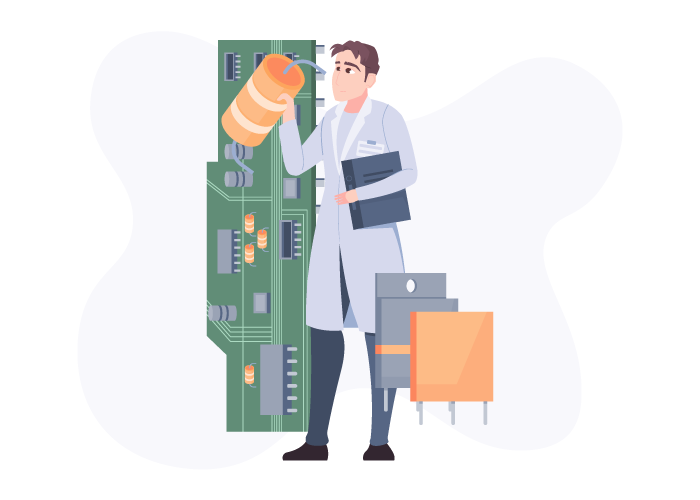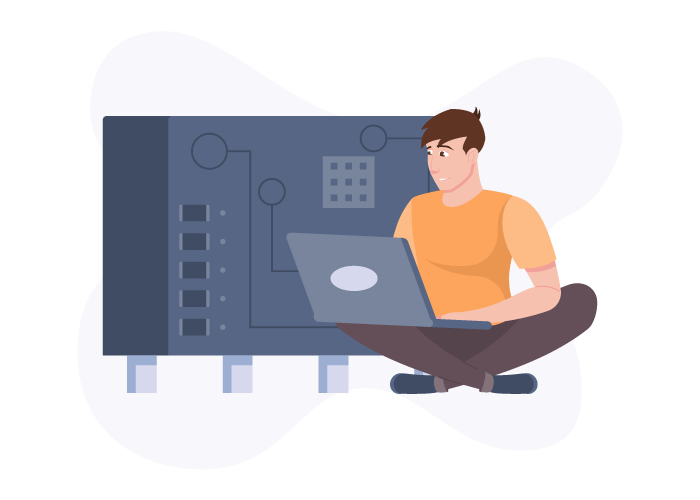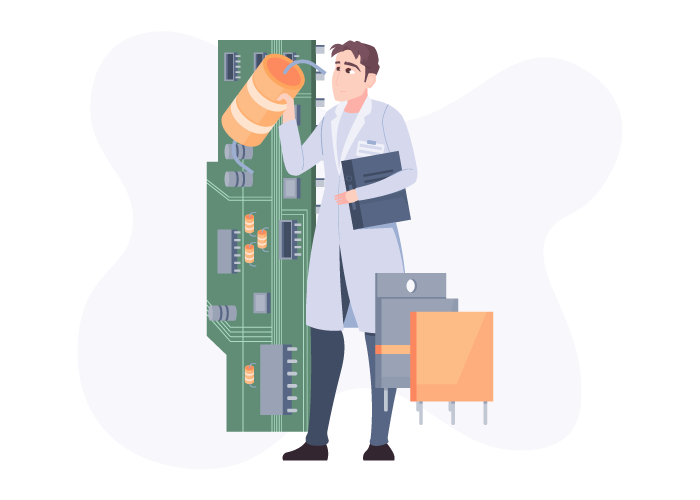Difference between Server RAM and Desktop RAM
Difference between Server RAM and Desktop RAM
With the ever-expanding technology and increasing need for computer systems, the use of servers and server systems for data processing and storage has also increased. In these server systems, RAM plays a significant and vital role. Memories are one of the essential components of any computer system that play a crucial role in its performance and operation.
Server RAM is a particular type of RAM specially designed for use in servers and large systems. The two RAMs differ in processing power, storage capacity, stability and reliability, scalability, and data presentation power. The differences between these two types of RAM show that server RAM is a better choice in some applications and systems that require high performance and stability. This research will help you decide whether to use server RAM versus regular RAM.
But on the other hand, regular RAM is still used in personal computers and standard systems. Is there a difference between the two? Is server RAM used in server systems for specific reasons? In the following, we will examine these differences and their role in the performance and different applications of these two types of RAM. So if you are curious about this, don’t miss this article, and if you are looking to buy a server with quality RAM to experience high speed, you can trust our servers. Go to the server purchase page to buy. Take virtual action. Our servers have the best hardware.
What is RAM?
RAM (Random Access Memory), or random access, is temporary memory in computers and other electronic devices. RAM is used to store data and programs running in real-time.
RAM can access data quickly and randomly. This means that any part of the data in RAM can be read or written independently at any time without having to access other parts sequentially. This feature gives high speed to RAM and makes it suitable for use as RAM in computers.
Data is stored in this type of memory using electronic circuits that can be read and written. When the power is cut off or the computer shuts down, the information in the RAM is lost because the RAM has the property of volatile memory. Therefore, RAM is not used to store data and files permanently, and its information must be reloaded every time the system is started.
RAM has different sizes and speeds and can be upgraded and installed on motherboards as modules. Usually, in modern computers and electronic devices, RAM is used as the main working memory, and data is transferred to it for use in processor memory.
What is regular RAM?
The components used for PCs and laptops are known as conventional RAM. These hardware parts are essential in the system’s performance, and the speed and performance of the computer or laptop directly depend on the amount of RAM. If the RAM is low, the system will be significantly slower. On the other hand, installing too much RAM does not add any advantage to the computer. When a program or file is opened on the computer, information is copied from the secondary memory to RAM and remains in RAM until the program or file is closed. Also, when the computer is turned on, RAM is used to load the operating system.
There are several ways to check the amount of RAM on your computer, including installing software. However, before that, you need to ensure that the memory you want to use is compatible with other components of the computer or laptop.
In general, memory modules differ in physical dimensions and information storage capacity in computers or laptops for each technology generation. These biological differences are made in the IT industry based on specific standards. One of the reasons for this standardization is that computer component manufacturers need to know the electrical and physical parameters of memory that can be installed on a computer or laptop processor.
Since any computer or laptop without RAM is practically unusable, regular RAM has advantages and disadvantages, which we will explain below.

Advantages and disadvantages of Desktop RAM
This section will examine the advantages and disadvantages of Desktop RAM.
Advantages of Desktop RAM
- High speed: Normal RAM makes programs and system functions run faster.
- High performance: compared to secondary storage (hard disk and SSD): conventional RAM performs better than secondary storage drives, such as hard disk or SSD, allowing faster data access.
- Lower power consumption: Conventional RAM consumes less power than disk drives, which can help extend the system’s battery life.
Disadvantages of Desktop RAM
Slow performance compared to CPU cache: Compared to CPU cache, regular RAM works slower, and this can slow down the overall system speed.
Errors and data loss: Like any other type of memory, regular RAM may experience errors, and in some cases, the information stored in it may be lost.
Space limitation: Normal RAM capacity is limited and cannot be easily upgraded. This limitation may make it difficult to use programs and large files.
What is a Ram server?
RAM server is also similar to standard RAM in its overall function. Still, due to the importance of data preservation and high speed in data reading and writing operations, RAM server has unique technologies that cause significant differences between them and regular RAM.
This type of memory has the same function as regular RAM. Still, due to the importance of preserving information and the high speed of reading and writing data in servers, server RAM has some special features and unique technologies that cause visible differences from regular RAM.

Pay attention to the following points when buying server RAM
- Number of users: If the number of users using your server simultaneously is high, consider a higher RAM to avoid quality loss.
- Database size: The size of data storage directly affects processing performance. If the data volume of your company or organization is less than 50 GB, 32 GB of RAM will be enough.
- Growth rate: Be aware of the projected growth in your database size and consider the need for upgrades in the coming years when choosing server RAM.
- Allocation of RAM to software: When buying server RAM, pay attention to the additional software used on the server. For example, on a server with 32 GB of RAM, typically 2 GB is used for the operating system and approximately 30 GB for SQL Server or other applications.
Click What is Monit? How to install and configure the Monit tool in Linux
By considering these points, you can choose the correct RAM server for the needs of your organization or company.
What is DDR technology in server RAM?
DDR technology in server RAM is a type of technology used in RAMs. Each generation of DDR is faster and performs better than the previous generation. This high speed is achieved with less energy consumption. Currently, there are five generations of DDR technology. With these explanations, you can understand what DDR5 means in regular computer RAM and server RAM.
The switch from DDR3 to DDR4 is fully justified among the various DDR technologies. DDR4 is almost twice as fast as DDR3 and uses a voltage of 1.2 volts, while DDR3 operates at around 1.5 or 1.35 volts. This makes the modules using DDR4 have the lowest power consumption compared to DDR3.
A newer generation of DDR technology, DDR5, was introduced in 2020. RAMs using DDR5 are approximately 5-15% faster than DDR4 RAMs. The operating voltage of these RAMs is also lower, around 1.1V, but their cost is also much higher. For this reason, many people still prefer to use DDR4 RAM.
Examining the differences between server RAM and regular RAM
In this section, we will explore the differences between server RAM and normal RAM.
Differences in resources
Desktops are only able to support one computer and have limited resources. They use 32-bit processors with one or two cores. On the other hand, servers can host multiple computers and have more robust resources.
Servers have a unique system for running and maintaining data, including powerful hard disks and quad-core processors with 64-bit power. Also, the servers are equipped with RAID functionality, which uses a unique data structure to automatically repair damaged hard drives without affecting server operations when they are detected.
Difference in support
Desktops can only support one computer and connect to it through client functionality. For this reason, their processors are designed with less power and a weaker CPU. On the contrary, servers have a more robust structure to host several computers through the power of a single server.

Difference in memory management (ECC memory)
Error correction mode (ECC) is a unique feature in some types of RAM that allows errors to be detected and corrected.
When ECC memory is used, the data flow in and out of the memory is controlled. This means that the processor does not need to access the temporary memory in the data processing process and only uses the main memory. Suppose the server’s memory is of ECC type. In that case, an error occurs during data transfer, and the signals are lost; the error detection process is performed so that only the missing information is sent again; there is no need to load the entire data. This feature increases the speed of the system.
ECC memory can detect missing data bits and send them to the memory section for more stable storage. Without requiring a command from the user or the processor, ECC detects and corrects errors in memory without the user’s knowledge.
ECC memory is more stable than non-ECC memory when transferring large amounts of data. For this reason, it is recommended not to install computer-specific memory on the server, as their stability is insufficient.
Servers carefully take care of their memory using ECC or Error Correction Code functionality. This function tests and corrects memory management bugs without affecting the processor and other operations. ECC generates a checksum when memory is loaded and recalculates when memory is unloaded.
Desktops use non-ECC memory management, which makes it very difficult to troubleshoot memory problems and may lead to incorrect results.
The difference in memory line
Desktops use a SIMM or single-line memory system with pins on only one side of the module, making the memory easy to maintain.
In contrast, servers use a DIMM or dual in-line memory module system, which has pins on both sides of the module and provides more robust memory management. Servers use an exceptional dynamic architecture to minimize errors in their connection operations.
The difference in price
The price of server RAM is usually higher than standard RAM. This price difference is due to the unique features and functions of the RAM Server, which make it suitable for loading and processing heavy network traffic.
Conclusion
In this article, we looked at the differences between server RAM and regular RAM. In short, RAM Server is a powerful tool available to improve the performance of servers and various applications. Focusing on optimization and higher performance, Ram Server’ss unique capabilities include more capacity, higher speed, and stability.
In contrast, standard RAM, mainly used in personal computers, has different capabilities. This type of RAM is generally designed for use in general applications and general consumption and, in some cases, may not be powerful enough for heavy applications and large servers.
However, RAM servers with many features such as ECC (Error Correction Code) and Buffered can prevent errors in data transmission and thus significantly improve system stability and data security.
Finally, in this article, we concluded that server RAM is suitable for servers and applications that have higwithments in terms performance, reliability, and data security. Considering the differences between server RAM and regular RAM, choosing the right type of RAM for each specific application can help improve system performance and performance.

